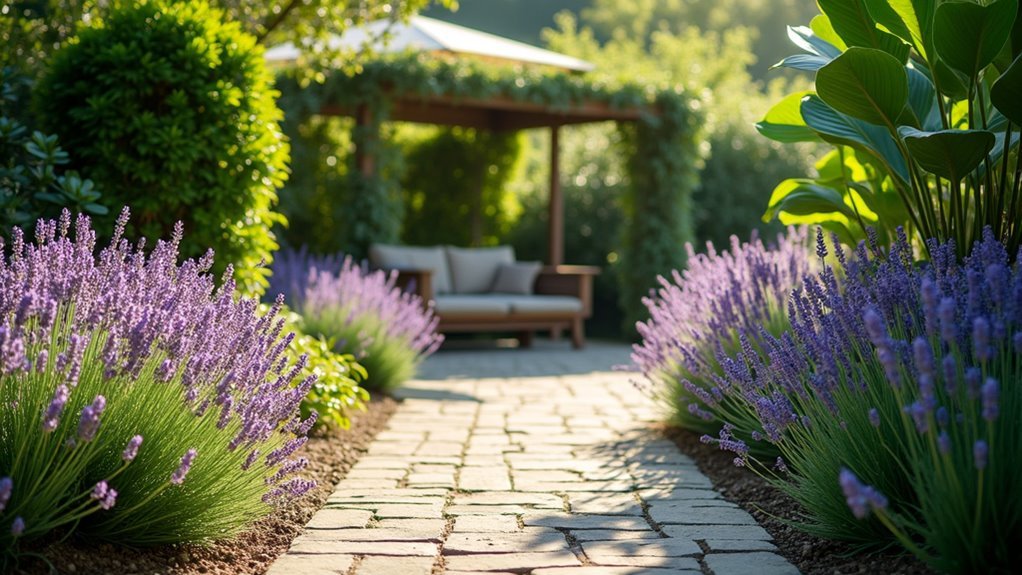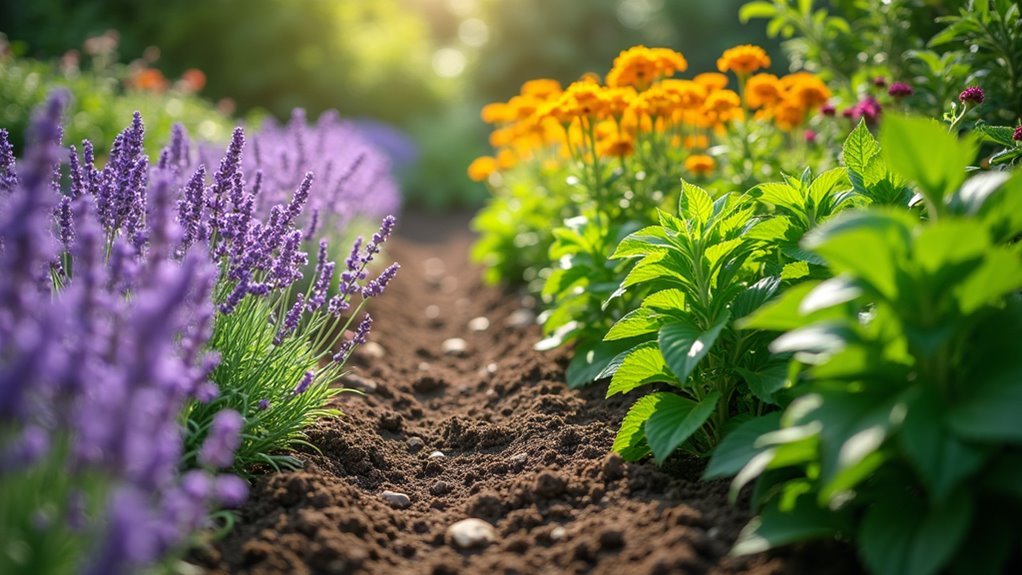You can create three powerful pest-repelling barriers by planting aromatic herbs like basil and rosemary, establishing perimeter protection with marigolds and nasturtiums, and strategically placing citronella and lavender around seating areas. These natural barriers repel mosquitoes, flies, aphids, and harmful beetles while attracting beneficial insects and pollinators. They’ll thrive in containers or garden beds with proper sunlight and drainage, eliminating your need for toxic chemicals while enhancing your garden’s beauty and discovering additional cultivation techniques.
Aromatic Herb Barriers Using Basil and Rosemary

While chemical pesticides can harm beneficial insects and contaminate your garden, aromatic herbs like basil and rosemary offer a natural alternative that’s both effective and environmentally friendly.
These pest-repelling plants create a natural barrier against unwanted pests while adding culinary value to your flavorful garden.
Plant basil in full sun with moist, well-draining soil to repel flies and mosquitoes. Crush the leaves to release volatile oils that enhance protection.
Rosemary thrives in full sun with excellent drainage, deterring cabbage moths and bean beetles with its woody fragrance.
Both aromatic herbs excel in container gardening, making them perfect for patios and decks.
You can harvest rosemary to create DIY pest sprays, maximizing your pest control efforts naturally.
Perimeter Protection With Marigolds and Nasturtiums
Since marigolds and nasturtiums excel at creating protective barriers around your garden’s perimeter, they’re perfect companions for establishing thorough pest defense. These annual flowers thrive in full sun with minimal water requirements, making them ideal for low-maintenance perimeter protection.
| Feature | Marigolds | Nasturtiums |
|---|---|---|
| Primary Function | Emit strong pest-deterring scent | Serve as trap crops with airborne chemicals |
| Target Pests | Mosquitoes, aphids, nematodes | Various harmful insects |
| Additional Benefits | Vibrant color, chemical-free protection | Attract beneficial insects, enhance plant health |
| Garden Impact | Natural barrier at borders | Improve overall yields |
Both varieties repel pests while preserving beneficial insects, creating a chemical-free environment. Plant them around vegetable garden edges to reduce pest populations and enjoy their vibrant color while maintaining effective pest-repelling barriers throughout the growing season.
Strategic Citronella and Lavender Placement Around Seating Areas

Transform your outdoor seating areas into comfortable, pest-free zones by strategically placing citronella grass and lavender around patios, decks, and garden benches.
Position citronella grass in large planters or at the back of flower beds to create tall, decorative barriers with proven mosquito repellent properties. Intersperse lavender along borders and pathways for maximum pest-repelling effectiveness through strategic placement.
Create natural mosquito barriers by positioning tall citronella grass in planters while interspersing fragrant lavender along walkways for strategic pest protection.
Both plants require 5-6 hours of daily sunlight and well-drained soil with thorough but infrequent watering.
When brushed against, lavender releases essential oils that impair mosquito senses, enhancing your outdoor seating protection.
This combination creates exceptional visual appeal while attracting beneficial pollinators like bees, establishing a balanced garden ecosystem that’s both functional and beautiful.
Frequently Asked Questions
What Plants Help Keep Pests Away?
You can plant lavender to repel mosquitoes and flies, marigolds around vegetables to deter aphids, mint in pots for ants, chrysanthemums for roaches, and citronella grass for mosquitoes.
What Plant Do Insects Hate the Most?
Catnip’s your best bet since it’s up to 10 times more effective than chemical repellents at deterring mosquitoes. It also repels deer ticks and cockroaches, making it incredibly versatile for pest control.
What Is the Best Insect Repellent Plant?
You’ll find catnip’s your best choice for insect repelling since it’s ten times more effective than chemical repellents against mosquitoes. It provides superior natural pest control compared to other plants.
What Plant Works as a Natural Pest Control?
You’ll find chrysanthemums work exceptionally well as natural pest control since they contain pyrethrum, a powerful natural insecticide that effectively repels roaches, ticks, fleas, and various other garden pests.
In Summary
You’ll notice fewer unwanted visitors once these natural barriers take root in your garden. Don’t wait for pest problems to escalate—start planting these strategic defenses now. Your outdoor spaces will become more enjoyable, and you’ll spend less time swatting away insects. These plants work around the clock, releasing their protective compounds naturally. You’ve got the blueprint for a pest-free yard, so grab your gardening tools and get started today.





Leave a Reply